Evaluating Agency Theory and Management Accounting in Literature
VerifiedAdded on 2020/05/11
|17
|3716
|134
AI Summary
The provided text offers an analysis of the principal-agent problem as it relates to accounting practices, specifically highlighting issues in corporate governance, financial reporting, and auditing processes. The discussion emphasizes how information asymmetry between principals (shareholders) and agents (management or auditors) can lead to adverse outcomes such as moral hazard and conflict of interest. It suggests solutions like enhanced transparency measures, rigorous auditing standards, and well-designed incentive structures to mitigate these issues. Additionally, it explores the implications of regulatory frameworks in maintaining accountability and aligning interests between different stakeholders. This critique aims to assess the text's depth in addressing these topics, its recommendations for practical applications, and any areas that may require further exploration or alternative perspectives.
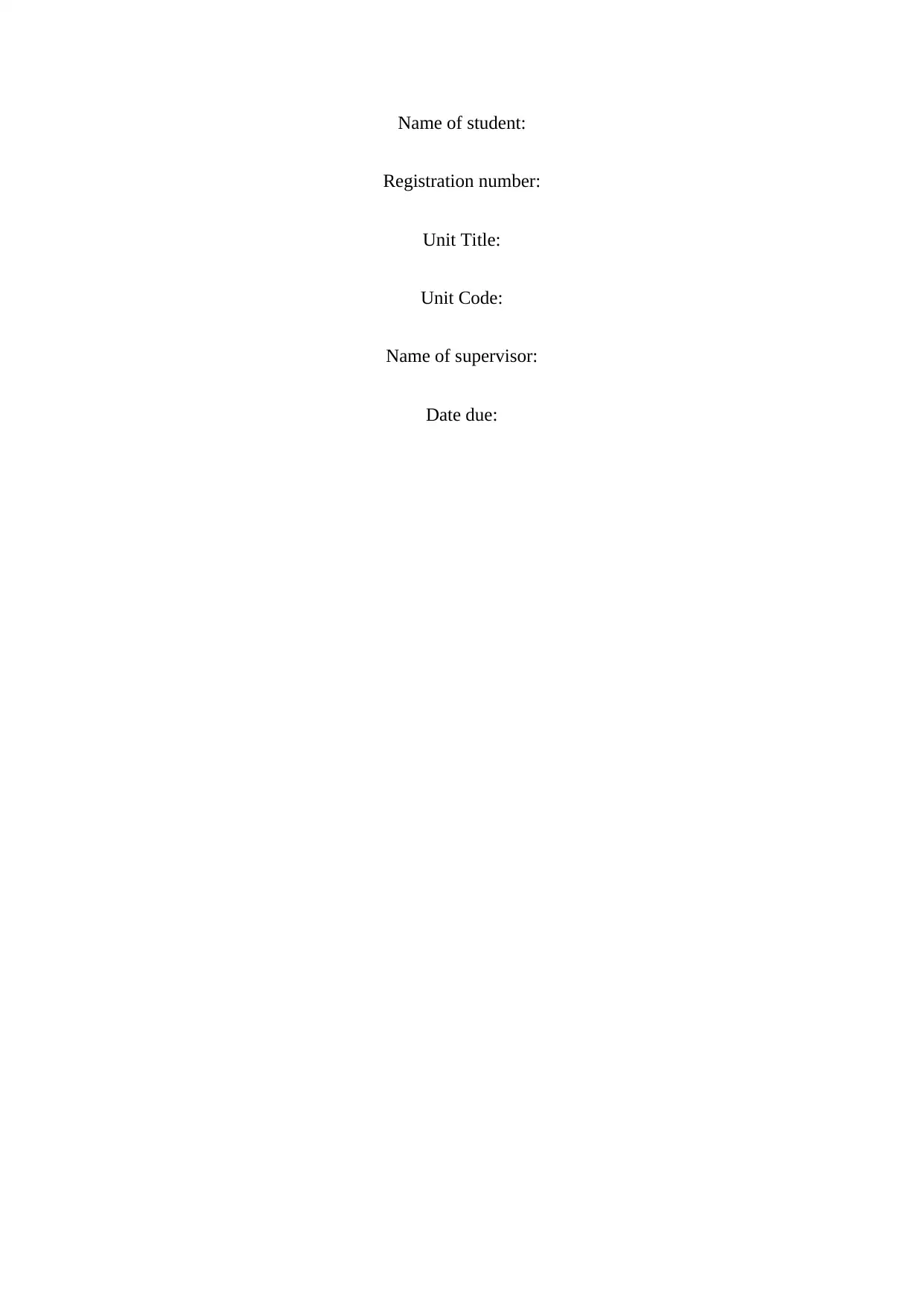
Name of student:
Registration number:
Unit Title:
Unit Code:
Name of supervisor:
Date due:
Registration number:
Unit Title:
Unit Code:
Name of supervisor:
Date due:
Paraphrase This Document
Need a fresh take? Get an instant paraphrase of this document with our AI Paraphraser


⊘ This is a preview!⊘
Do you want full access?
Subscribe today to unlock all pages.

Trusted by 1+ million students worldwide
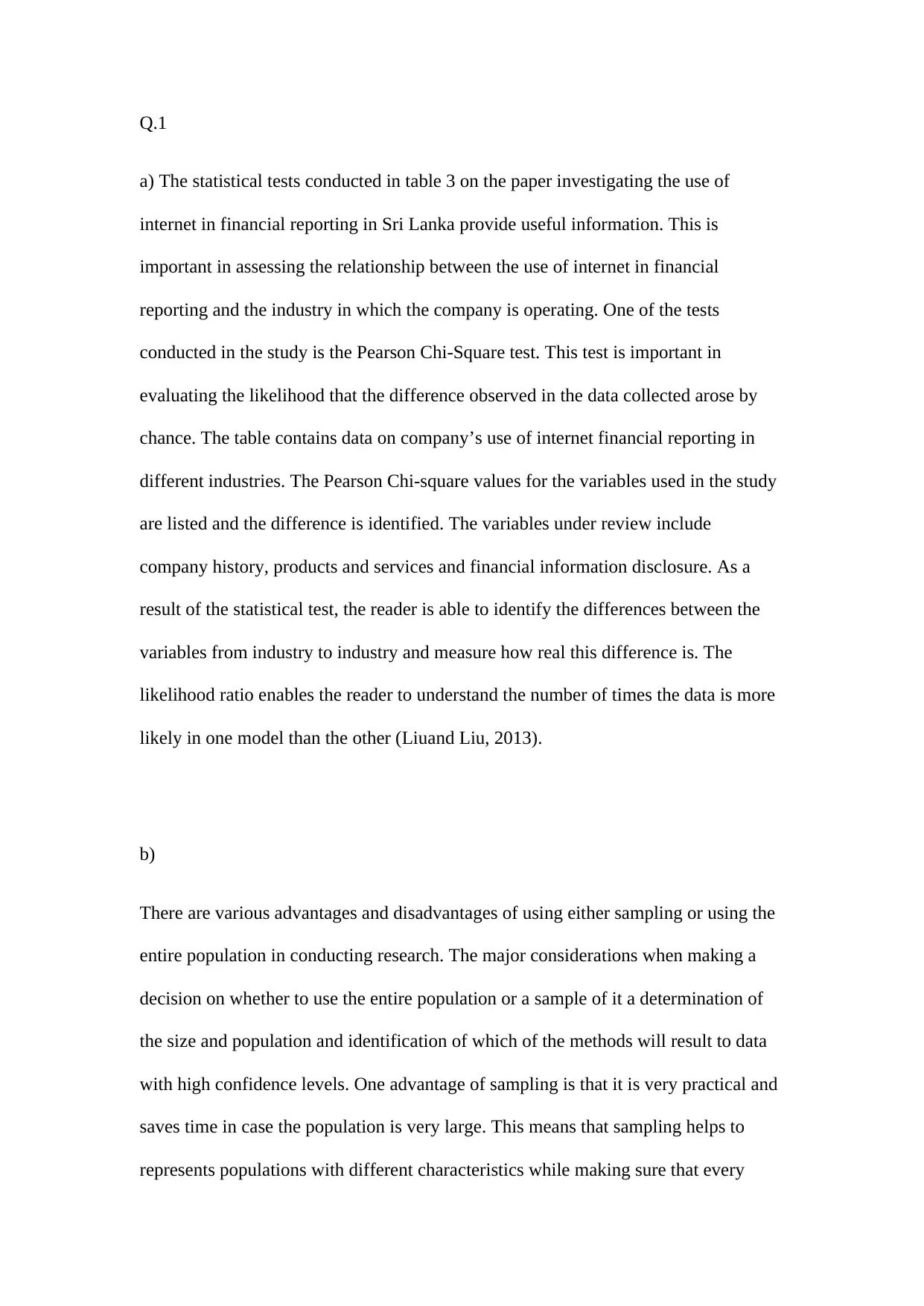
Q.1
a) The statistical tests conducted in table 3 on the paper investigating the use of
internet in financial reporting in Sri Lanka provide useful information. This is
important in assessing the relationship between the use of internet in financial
reporting and the industry in which the company is operating. One of the tests
conducted in the study is the Pearson Chi-Square test. This test is important in
evaluating the likelihood that the difference observed in the data collected arose by
chance. The table contains data on company’s use of internet financial reporting in
different industries. The Pearson Chi-square values for the variables used in the study
are listed and the difference is identified. The variables under review include
company history, products and services and financial information disclosure. As a
result of the statistical test, the reader is able to identify the differences between the
variables from industry to industry and measure how real this difference is. The
likelihood ratio enables the reader to understand the number of times the data is more
likely in one model than the other (Liuand Liu, 2013).
b)
There are various advantages and disadvantages of using either sampling or using the
entire population in conducting research. The major considerations when making a
decision on whether to use the entire population or a sample of it a determination of
the size and population and identification of which of the methods will result to data
with high confidence levels. One advantage of sampling is that it is very practical and
saves time in case the population is very large. This means that sampling helps to
represents populations with different characteristics while making sure that every
a) The statistical tests conducted in table 3 on the paper investigating the use of
internet in financial reporting in Sri Lanka provide useful information. This is
important in assessing the relationship between the use of internet in financial
reporting and the industry in which the company is operating. One of the tests
conducted in the study is the Pearson Chi-Square test. This test is important in
evaluating the likelihood that the difference observed in the data collected arose by
chance. The table contains data on company’s use of internet financial reporting in
different industries. The Pearson Chi-square values for the variables used in the study
are listed and the difference is identified. The variables under review include
company history, products and services and financial information disclosure. As a
result of the statistical test, the reader is able to identify the differences between the
variables from industry to industry and measure how real this difference is. The
likelihood ratio enables the reader to understand the number of times the data is more
likely in one model than the other (Liuand Liu, 2013).
b)
There are various advantages and disadvantages of using either sampling or using the
entire population in conducting research. The major considerations when making a
decision on whether to use the entire population or a sample of it a determination of
the size and population and identification of which of the methods will result to data
with high confidence levels. One advantage of sampling is that it is very practical and
saves time in case the population is very large. This means that sampling helps to
represents populations with different characteristics while making sure that every
Paraphrase This Document
Need a fresh take? Get an instant paraphrase of this document with our AI Paraphraser
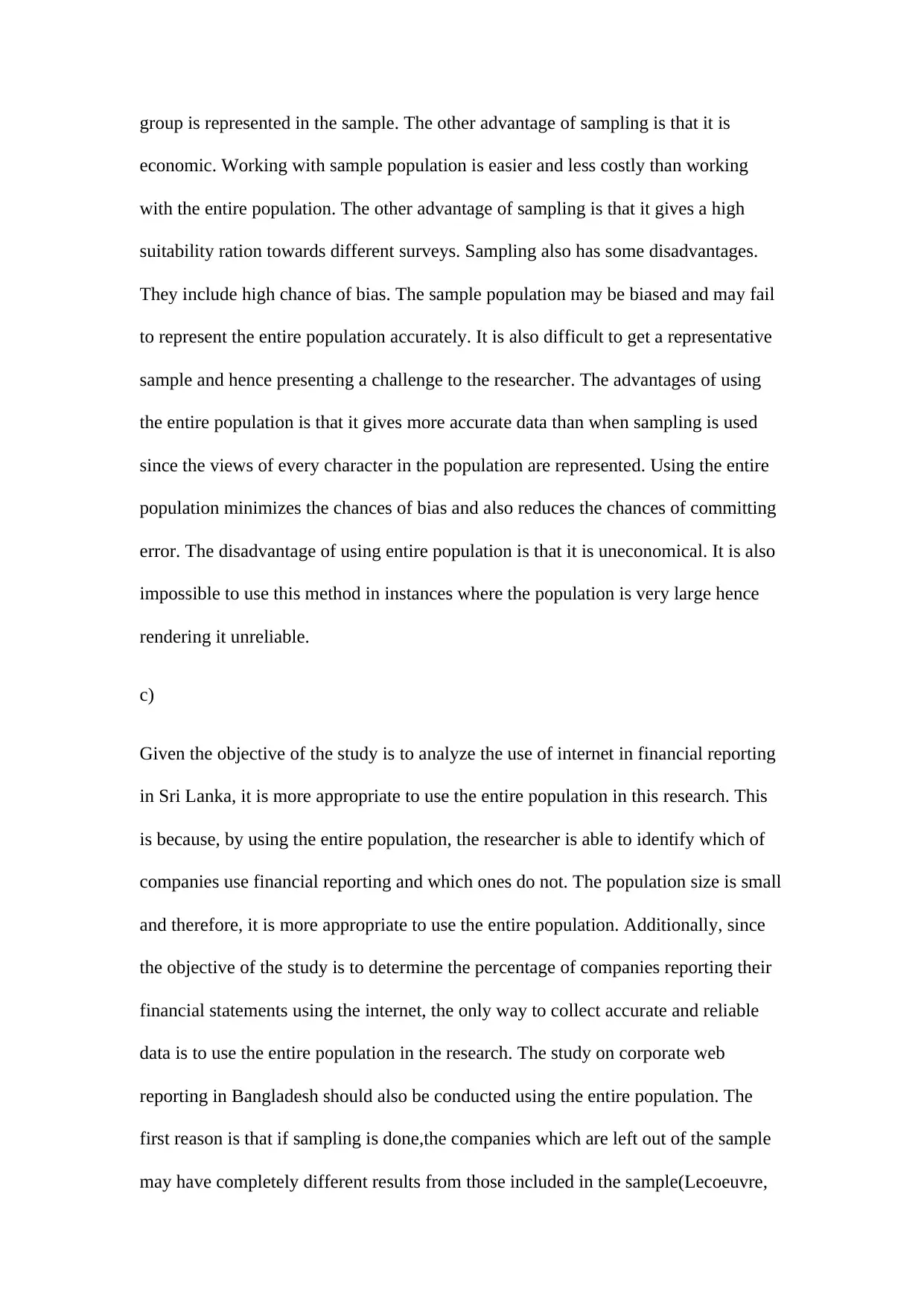
group is represented in the sample. The other advantage of sampling is that it is
economic. Working with sample population is easier and less costly than working
with the entire population. The other advantage of sampling is that it gives a high
suitability ration towards different surveys. Sampling also has some disadvantages.
They include high chance of bias. The sample population may be biased and may fail
to represent the entire population accurately. It is also difficult to get a representative
sample and hence presenting a challenge to the researcher. The advantages of using
the entire population is that it gives more accurate data than when sampling is used
since the views of every character in the population are represented. Using the entire
population minimizes the chances of bias and also reduces the chances of committing
error. The disadvantage of using entire population is that it is uneconomical. It is also
impossible to use this method in instances where the population is very large hence
rendering it unreliable.
c)
Given the objective of the study is to analyze the use of internet in financial reporting
in Sri Lanka, it is more appropriate to use the entire population in this research. This
is because, by using the entire population, the researcher is able to identify which of
companies use financial reporting and which ones do not. The population size is small
and therefore, it is more appropriate to use the entire population. Additionally, since
the objective of the study is to determine the percentage of companies reporting their
financial statements using the internet, the only way to collect accurate and reliable
data is to use the entire population in the research. The study on corporate web
reporting in Bangladesh should also be conducted using the entire population. The
first reason is that if sampling is done,the companies which are left out of the sample
may have completely different results from those included in the sample(Lecoeuvre,
economic. Working with sample population is easier and less costly than working
with the entire population. The other advantage of sampling is that it gives a high
suitability ration towards different surveys. Sampling also has some disadvantages.
They include high chance of bias. The sample population may be biased and may fail
to represent the entire population accurately. It is also difficult to get a representative
sample and hence presenting a challenge to the researcher. The advantages of using
the entire population is that it gives more accurate data than when sampling is used
since the views of every character in the population are represented. Using the entire
population minimizes the chances of bias and also reduces the chances of committing
error. The disadvantage of using entire population is that it is uneconomical. It is also
impossible to use this method in instances where the population is very large hence
rendering it unreliable.
c)
Given the objective of the study is to analyze the use of internet in financial reporting
in Sri Lanka, it is more appropriate to use the entire population in this research. This
is because, by using the entire population, the researcher is able to identify which of
companies use financial reporting and which ones do not. The population size is small
and therefore, it is more appropriate to use the entire population. Additionally, since
the objective of the study is to determine the percentage of companies reporting their
financial statements using the internet, the only way to collect accurate and reliable
data is to use the entire population in the research. The study on corporate web
reporting in Bangladesh should also be conducted using the entire population. The
first reason is that if sampling is done,the companies which are left out of the sample
may have completely different results from those included in the sample(Lecoeuvre,
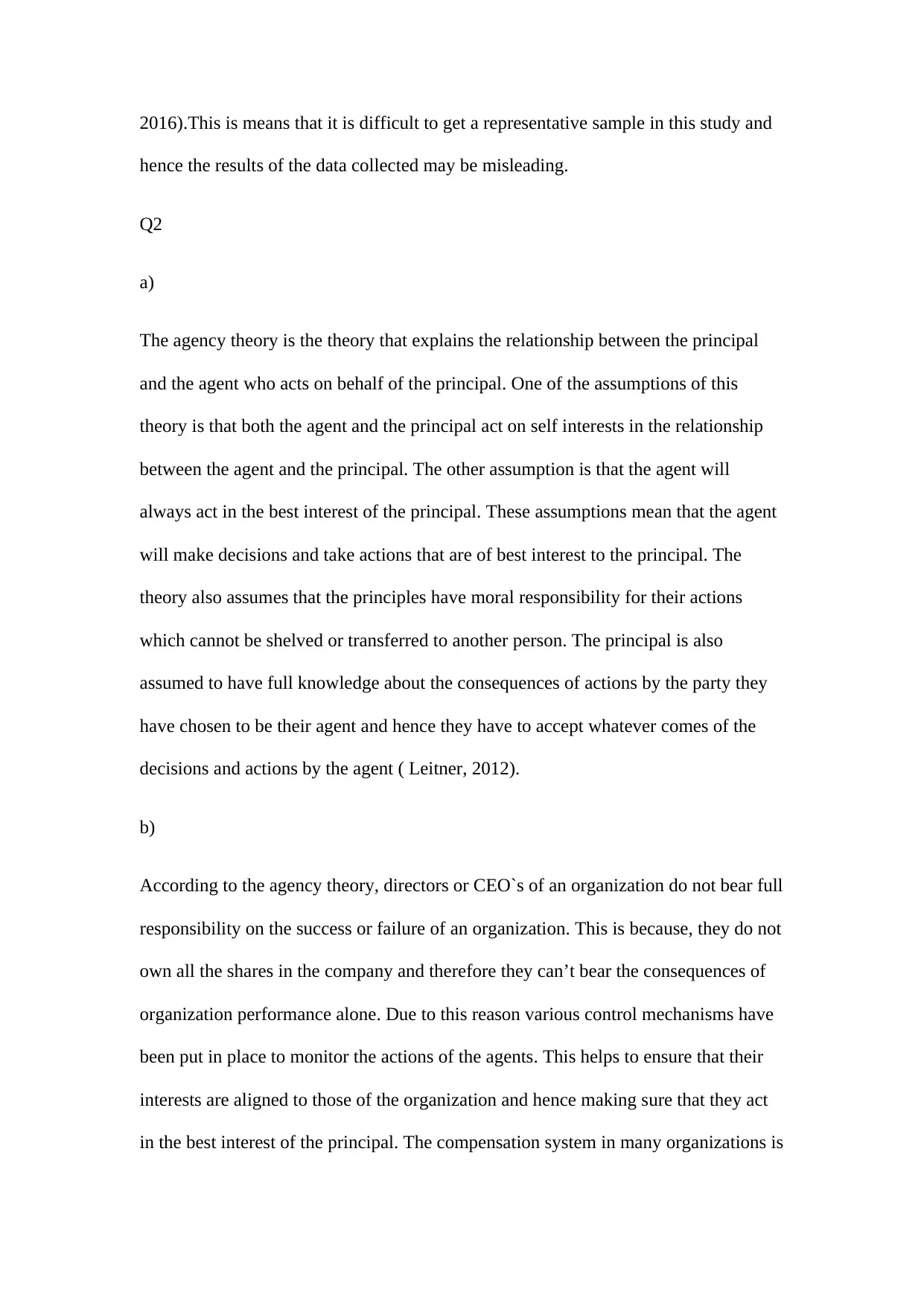
2016).This is means that it is difficult to get a representative sample in this study and
hence the results of the data collected may be misleading.
Q2
a)
The agency theory is the theory that explains the relationship between the principal
and the agent who acts on behalf of the principal. One of the assumptions of this
theory is that both the agent and the principal act on self interests in the relationship
between the agent and the principal. The other assumption is that the agent will
always act in the best interest of the principal. These assumptions mean that the agent
will make decisions and take actions that are of best interest to the principal. The
theory also assumes that the principles have moral responsibility for their actions
which cannot be shelved or transferred to another person. The principal is also
assumed to have full knowledge about the consequences of actions by the party they
have chosen to be their agent and hence they have to accept whatever comes of the
decisions and actions by the agent ( Leitner, 2012).
b)
According to the agency theory, directors or CEO`s of an organization do not bear full
responsibility on the success or failure of an organization. This is because, they do not
own all the shares in the company and therefore they can’t bear the consequences of
organization performance alone. Due to this reason various control mechanisms have
been put in place to monitor the actions of the agents. This helps to ensure that their
interests are aligned to those of the organization and hence making sure that they act
in the best interest of the principal. The compensation system in many organizations is
hence the results of the data collected may be misleading.
Q2
a)
The agency theory is the theory that explains the relationship between the principal
and the agent who acts on behalf of the principal. One of the assumptions of this
theory is that both the agent and the principal act on self interests in the relationship
between the agent and the principal. The other assumption is that the agent will
always act in the best interest of the principal. These assumptions mean that the agent
will make decisions and take actions that are of best interest to the principal. The
theory also assumes that the principles have moral responsibility for their actions
which cannot be shelved or transferred to another person. The principal is also
assumed to have full knowledge about the consequences of actions by the party they
have chosen to be their agent and hence they have to accept whatever comes of the
decisions and actions by the agent ( Leitner, 2012).
b)
According to the agency theory, directors or CEO`s of an organization do not bear full
responsibility on the success or failure of an organization. This is because, they do not
own all the shares in the company and therefore they can’t bear the consequences of
organization performance alone. Due to this reason various control mechanisms have
been put in place to monitor the actions of the agents. This helps to ensure that their
interests are aligned to those of the organization and hence making sure that they act
in the best interest of the principal. The compensation system in many organizations is
⊘ This is a preview!⊘
Do you want full access?
Subscribe today to unlock all pages.

Trusted by 1+ million students worldwide
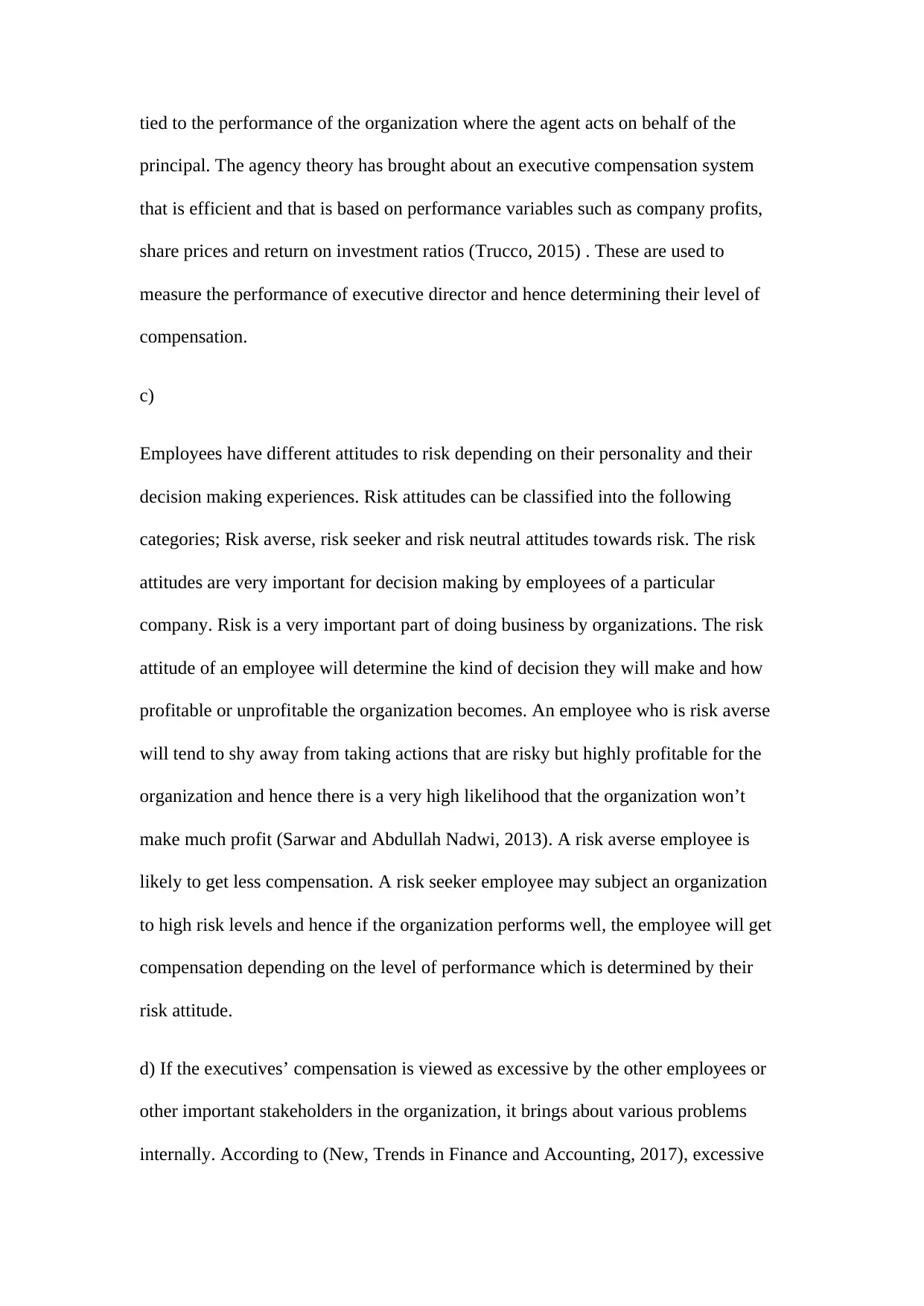
tied to the performance of the organization where the agent acts on behalf of the
principal. The agency theory has brought about an executive compensation system
that is efficient and that is based on performance variables such as company profits,
share prices and return on investment ratios (Trucco, 2015) . These are used to
measure the performance of executive director and hence determining their level of
compensation.
c)
Employees have different attitudes to risk depending on their personality and their
decision making experiences. Risk attitudes can be classified into the following
categories; Risk averse, risk seeker and risk neutral attitudes towards risk. The risk
attitudes are very important for decision making by employees of a particular
company. Risk is a very important part of doing business by organizations. The risk
attitude of an employee will determine the kind of decision they will make and how
profitable or unprofitable the organization becomes. An employee who is risk averse
will tend to shy away from taking actions that are risky but highly profitable for the
organization and hence there is a very high likelihood that the organization won’t
make much profit (Sarwar and Abdullah Nadwi, 2013). A risk averse employee is
likely to get less compensation. A risk seeker employee may subject an organization
to high risk levels and hence if the organization performs well, the employee will get
compensation depending on the level of performance which is determined by their
risk attitude.
d) If the executives’ compensation is viewed as excessive by the other employees or
other important stakeholders in the organization, it brings about various problems
internally. According to (New, Trends in Finance and Accounting, 2017), excessive
principal. The agency theory has brought about an executive compensation system
that is efficient and that is based on performance variables such as company profits,
share prices and return on investment ratios (Trucco, 2015) . These are used to
measure the performance of executive director and hence determining their level of
compensation.
c)
Employees have different attitudes to risk depending on their personality and their
decision making experiences. Risk attitudes can be classified into the following
categories; Risk averse, risk seeker and risk neutral attitudes towards risk. The risk
attitudes are very important for decision making by employees of a particular
company. Risk is a very important part of doing business by organizations. The risk
attitude of an employee will determine the kind of decision they will make and how
profitable or unprofitable the organization becomes. An employee who is risk averse
will tend to shy away from taking actions that are risky but highly profitable for the
organization and hence there is a very high likelihood that the organization won’t
make much profit (Sarwar and Abdullah Nadwi, 2013). A risk averse employee is
likely to get less compensation. A risk seeker employee may subject an organization
to high risk levels and hence if the organization performs well, the employee will get
compensation depending on the level of performance which is determined by their
risk attitude.
d) If the executives’ compensation is viewed as excessive by the other employees or
other important stakeholders in the organization, it brings about various problems
internally. According to (New, Trends in Finance and Accounting, 2017), excessive
Paraphrase This Document
Need a fresh take? Get an instant paraphrase of this document with our AI Paraphraser
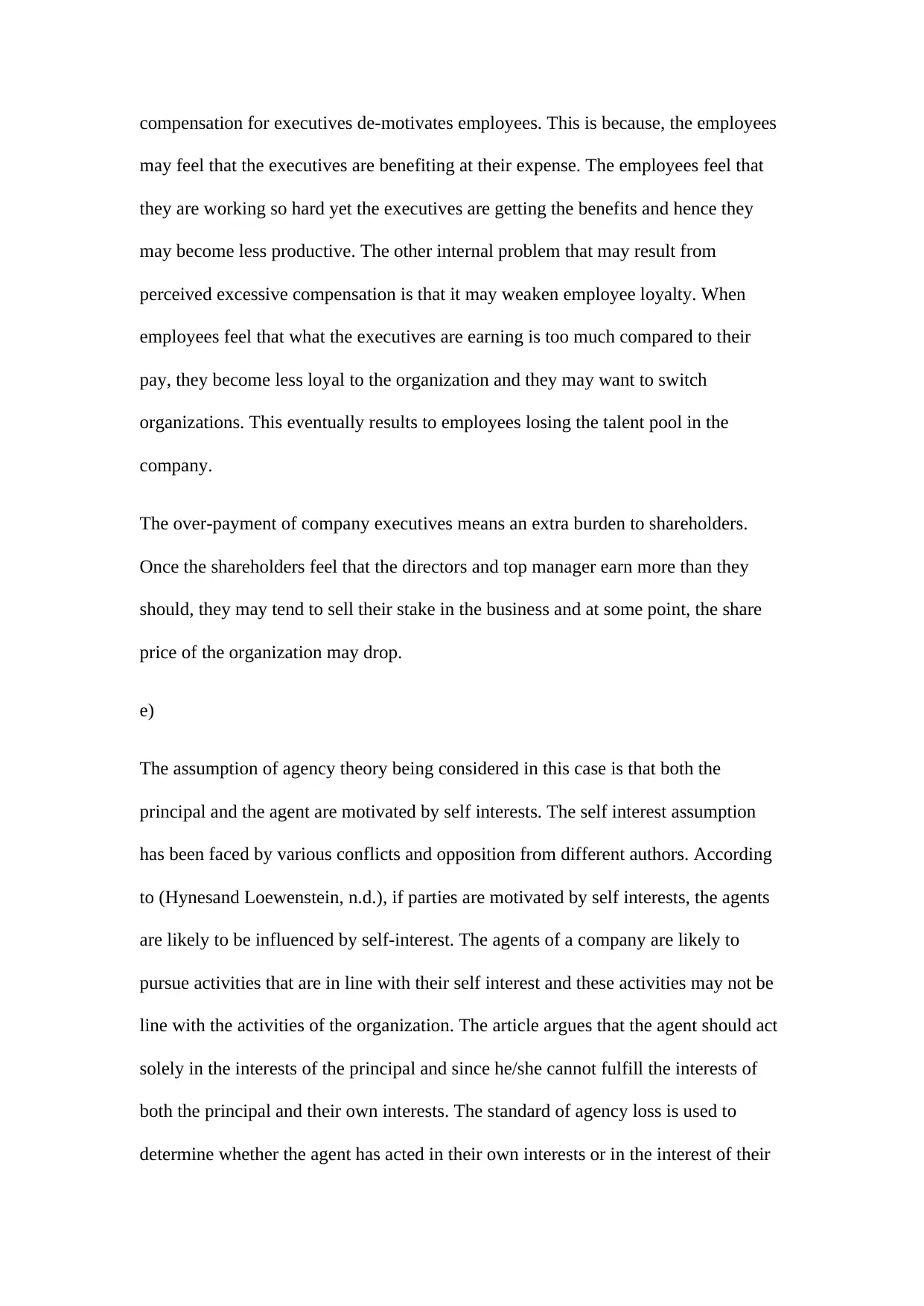
compensation for executives de-motivates employees. This is because, the employees
may feel that the executives are benefiting at their expense. The employees feel that
they are working so hard yet the executives are getting the benefits and hence they
may become less productive. The other internal problem that may result from
perceived excessive compensation is that it may weaken employee loyalty. When
employees feel that what the executives are earning is too much compared to their
pay, they become less loyal to the organization and they may want to switch
organizations. This eventually results to employees losing the talent pool in the
company.
The over-payment of company executives means an extra burden to shareholders.
Once the shareholders feel that the directors and top manager earn more than they
should, they may tend to sell their stake in the business and at some point, the share
price of the organization may drop.
e)
The assumption of agency theory being considered in this case is that both the
principal and the agent are motivated by self interests. The self interest assumption
has been faced by various conflicts and opposition from different authors. According
to (Hynesand Loewenstein, n.d.), if parties are motivated by self interests, the agents
are likely to be influenced by self-interest. The agents of a company are likely to
pursue activities that are in line with their self interest and these activities may not be
line with the activities of the organization. The article argues that the agent should act
solely in the interests of the principal and since he/she cannot fulfill the interests of
both the principal and their own interests. The standard of agency loss is used to
determine whether the agent has acted in their own interests or in the interest of their
may feel that the executives are benefiting at their expense. The employees feel that
they are working so hard yet the executives are getting the benefits and hence they
may become less productive. The other internal problem that may result from
perceived excessive compensation is that it may weaken employee loyalty. When
employees feel that what the executives are earning is too much compared to their
pay, they become less loyal to the organization and they may want to switch
organizations. This eventually results to employees losing the talent pool in the
company.
The over-payment of company executives means an extra burden to shareholders.
Once the shareholders feel that the directors and top manager earn more than they
should, they may tend to sell their stake in the business and at some point, the share
price of the organization may drop.
e)
The assumption of agency theory being considered in this case is that both the
principal and the agent are motivated by self interests. The self interest assumption
has been faced by various conflicts and opposition from different authors. According
to (Hynesand Loewenstein, n.d.), if parties are motivated by self interests, the agents
are likely to be influenced by self-interest. The agents of a company are likely to
pursue activities that are in line with their self interest and these activities may not be
line with the activities of the organization. The article argues that the agent should act
solely in the interests of the principal and since he/she cannot fulfill the interests of
both the principal and their own interests. The standard of agency loss is used to
determine whether the agent has acted in their own interests or in the interest of their
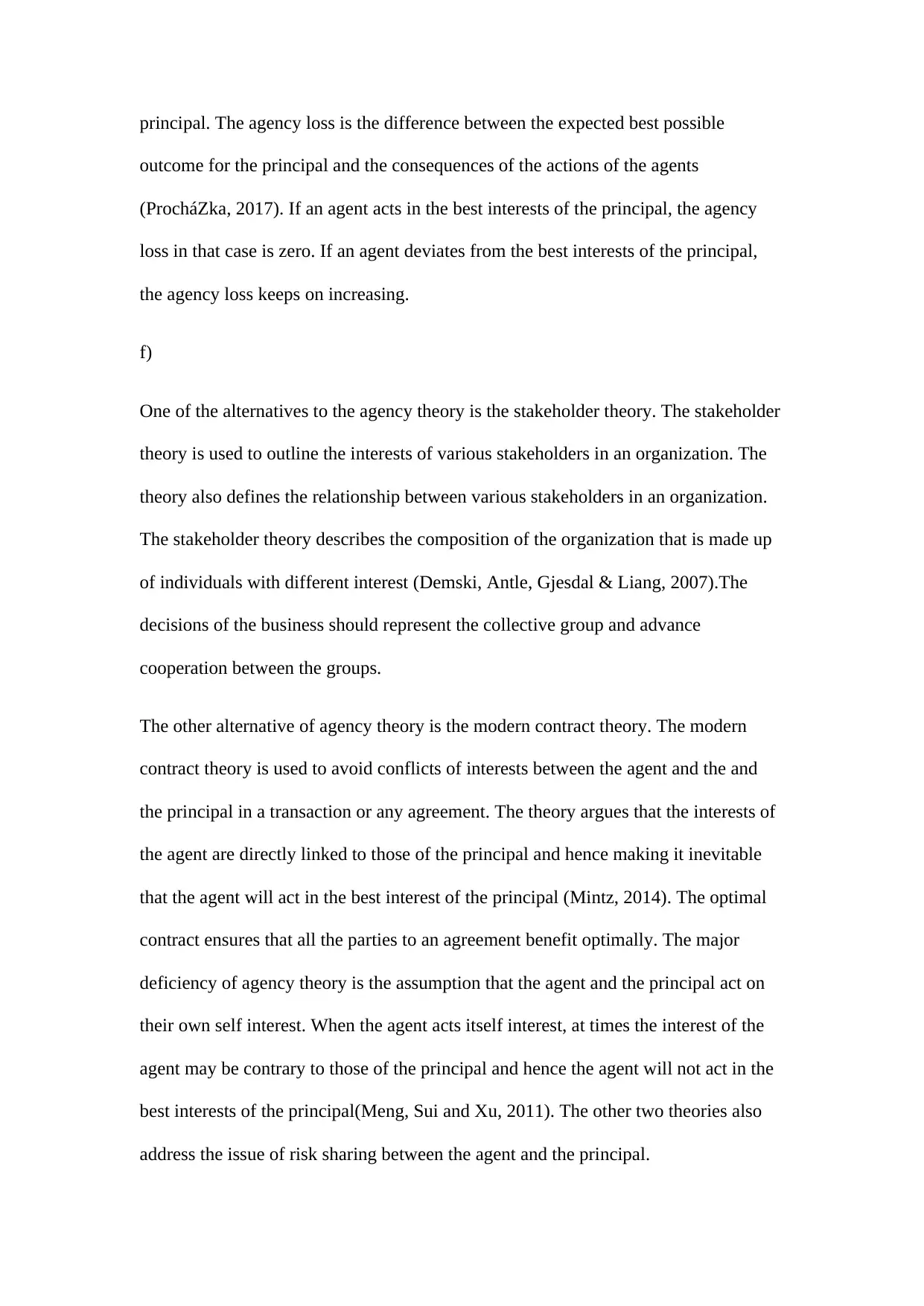
principal. The agency loss is the difference between the expected best possible
outcome for the principal and the consequences of the actions of the agents
(ProcháZka, 2017) . If an agent acts in the best interests of the principal, the agency
loss in that case is zero. If an agent deviates from the best interests of the principal,
the agency loss keeps on increasing.
f)
One of the alternatives to the agency theory is the stakeholder theory. The stakeholder
theory is used to outline the interests of various stakeholders in an organization. The
theory also defines the relationship between various stakeholders in an organization.
The stakeholder theory describes the composition of the organization that is made up
of individuals with different interest (Demski, Antle, Gjesdal & Liang, 2007).The
decisions of the business should represent the collective group and advance
cooperation between the groups.
The other alternative of agency theory is the modern contract theory. The modern
contract theory is used to avoid conflicts of interests between the agent and the and
the principal in a transaction or any agreement. The theory argues that the interests of
the agent are directly linked to those of the principal and hence making it inevitable
that the agent will act in the best interest of the principal (Mintz, 2014). The optimal
contract ensures that all the parties to an agreement benefit optimally. The major
deficiency of agency theory is the assumption that the agent and the principal act on
their own self interest. When the agent acts itself interest, at times the interest of the
agent may be contrary to those of the principal and hence the agent will not act in the
best interests of the principal(Meng, Sui and Xu, 2011). The other two theories also
address the issue of risk sharing between the agent and the principal.
outcome for the principal and the consequences of the actions of the agents
(ProcháZka, 2017) . If an agent acts in the best interests of the principal, the agency
loss in that case is zero. If an agent deviates from the best interests of the principal,
the agency loss keeps on increasing.
f)
One of the alternatives to the agency theory is the stakeholder theory. The stakeholder
theory is used to outline the interests of various stakeholders in an organization. The
theory also defines the relationship between various stakeholders in an organization.
The stakeholder theory describes the composition of the organization that is made up
of individuals with different interest (Demski, Antle, Gjesdal & Liang, 2007).The
decisions of the business should represent the collective group and advance
cooperation between the groups.
The other alternative of agency theory is the modern contract theory. The modern
contract theory is used to avoid conflicts of interests between the agent and the and
the principal in a transaction or any agreement. The theory argues that the interests of
the agent are directly linked to those of the principal and hence making it inevitable
that the agent will act in the best interest of the principal (Mintz, 2014). The optimal
contract ensures that all the parties to an agreement benefit optimally. The major
deficiency of agency theory is the assumption that the agent and the principal act on
their own self interest. When the agent acts itself interest, at times the interest of the
agent may be contrary to those of the principal and hence the agent will not act in the
best interests of the principal(Meng, Sui and Xu, 2011). The other two theories also
address the issue of risk sharing between the agent and the principal.
⊘ This is a preview!⊘
Do you want full access?
Subscribe today to unlock all pages.

Trusted by 1+ million students worldwide
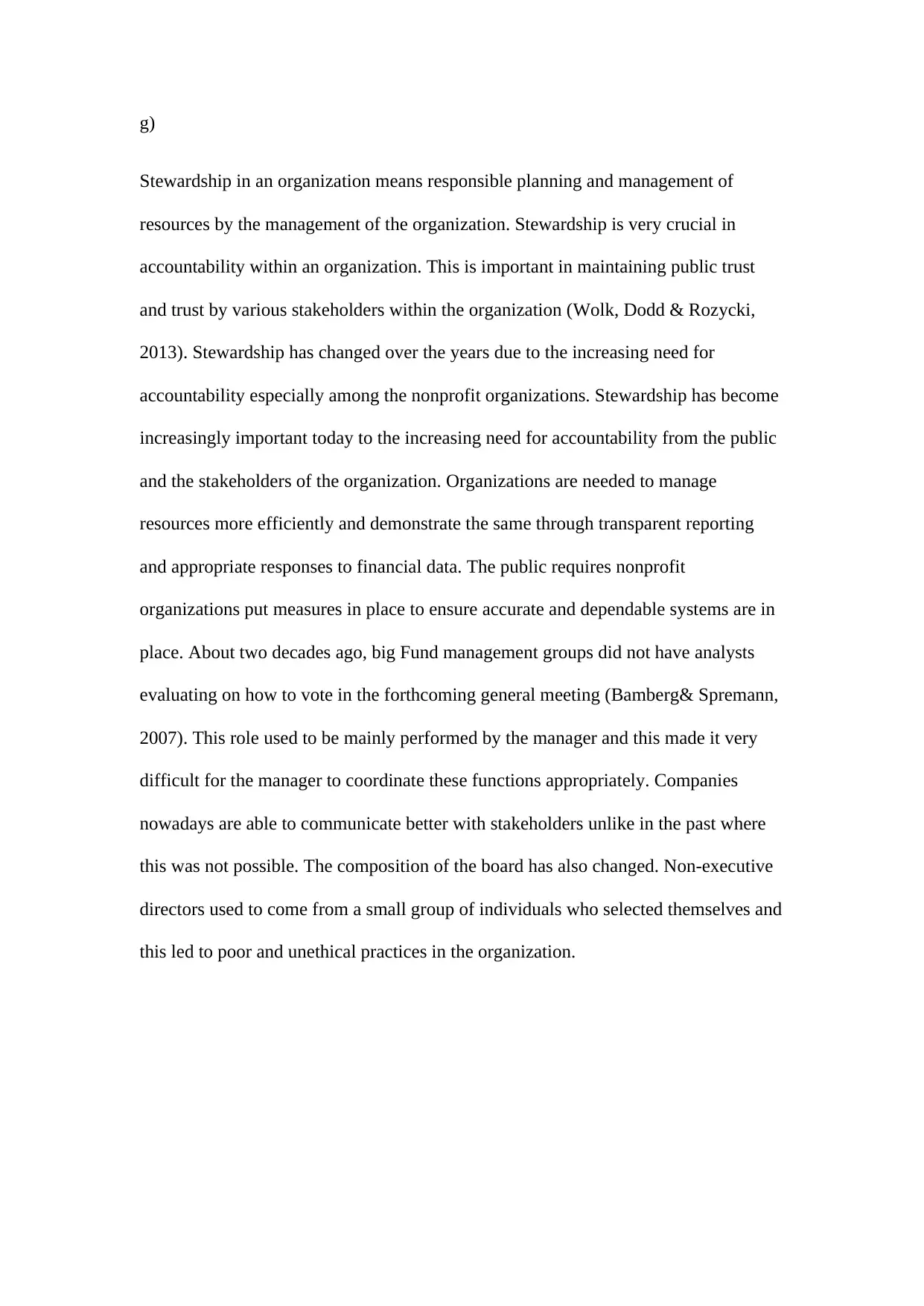
g)
Stewardship in an organization means responsible planning and management of
resources by the management of the organization. Stewardship is very crucial in
accountability within an organization. This is important in maintaining public trust
and trust by various stakeholders within the organization (Wolk, Dodd & Rozycki,
2013). Stewardship has changed over the years due to the increasing need for
accountability especially among the nonprofit organizations. Stewardship has become
increasingly important today to the increasing need for accountability from the public
and the stakeholders of the organization. Organizations are needed to manage
resources more efficiently and demonstrate the same through transparent reporting
and appropriate responses to financial data. The public requires nonprofit
organizations put measures in place to ensure accurate and dependable systems are in
place. About two decades ago, big Fund management groups did not have analysts
evaluating on how to vote in the forthcoming general meeting (Bamberg& Spremann,
2007). This role used to be mainly performed by the manager and this made it very
difficult for the manager to coordinate these functions appropriately. Companies
nowadays are able to communicate better with stakeholders unlike in the past where
this was not possible. The composition of the board has also changed. Non-executive
directors used to come from a small group of individuals who selected themselves and
this led to poor and unethical practices in the organization.
Stewardship in an organization means responsible planning and management of
resources by the management of the organization. Stewardship is very crucial in
accountability within an organization. This is important in maintaining public trust
and trust by various stakeholders within the organization (Wolk, Dodd & Rozycki,
2013). Stewardship has changed over the years due to the increasing need for
accountability especially among the nonprofit organizations. Stewardship has become
increasingly important today to the increasing need for accountability from the public
and the stakeholders of the organization. Organizations are needed to manage
resources more efficiently and demonstrate the same through transparent reporting
and appropriate responses to financial data. The public requires nonprofit
organizations put measures in place to ensure accurate and dependable systems are in
place. About two decades ago, big Fund management groups did not have analysts
evaluating on how to vote in the forthcoming general meeting (Bamberg& Spremann,
2007). This role used to be mainly performed by the manager and this made it very
difficult for the manager to coordinate these functions appropriately. Companies
nowadays are able to communicate better with stakeholders unlike in the past where
this was not possible. The composition of the board has also changed. Non-executive
directors used to come from a small group of individuals who selected themselves and
this led to poor and unethical practices in the organization.
Paraphrase This Document
Need a fresh take? Get an instant paraphrase of this document with our AI Paraphraser
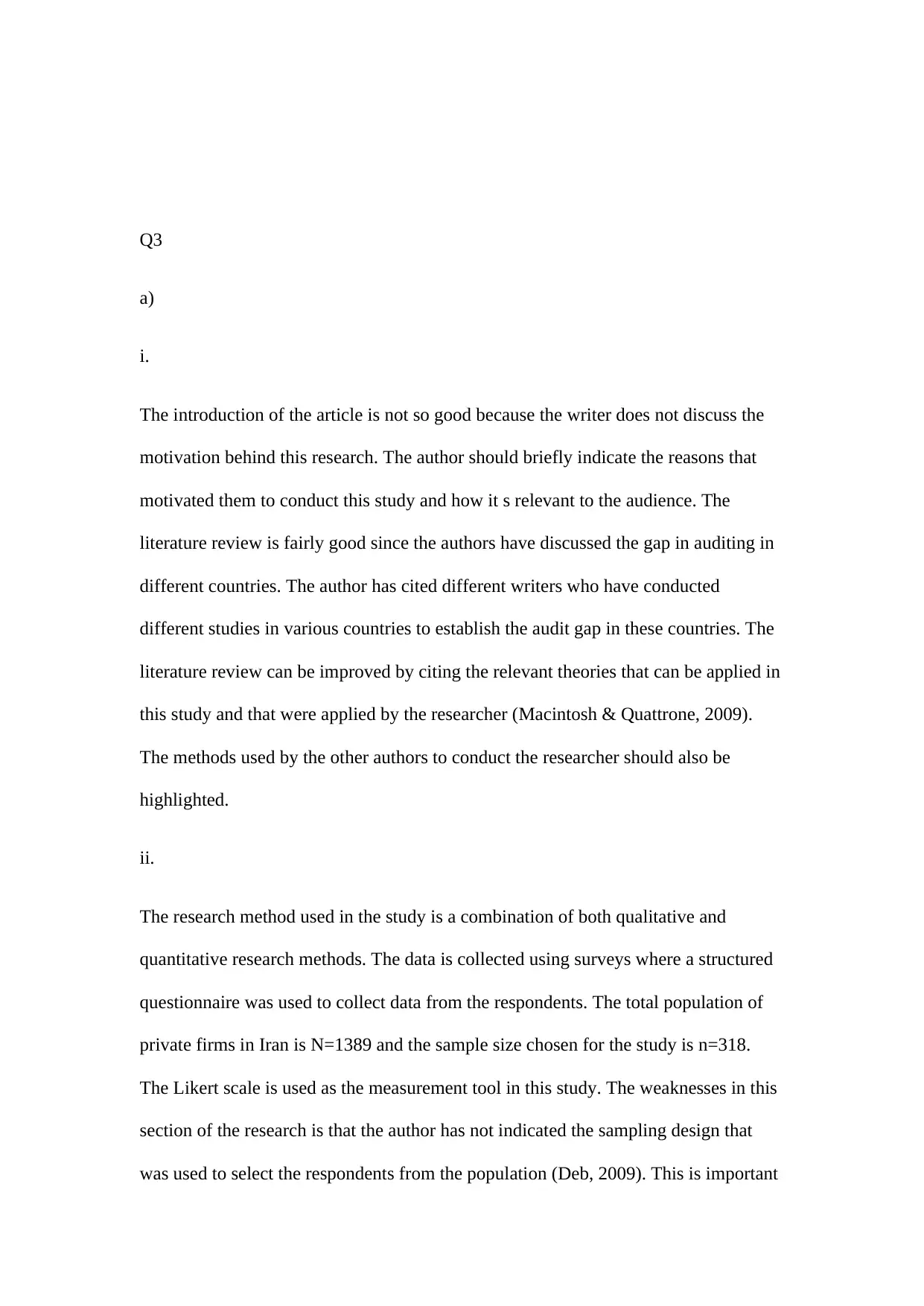
Q3
a)
i.
The introduction of the article is not so good because the writer does not discuss the
motivation behind this research. The author should briefly indicate the reasons that
motivated them to conduct this study and how it s relevant to the audience. The
literature review is fairly good since the authors have discussed the gap in auditing in
different countries. The author has cited different writers who have conducted
different studies in various countries to establish the audit gap in these countries. The
literature review can be improved by citing the relevant theories that can be applied in
this study and that were applied by the researcher (Macintosh & Quattrone, 2009).
The methods used by the other authors to conduct the researcher should also be
highlighted.
ii.
The research method used in the study is a combination of both qualitative and
quantitative research methods. The data is collected using surveys where a structured
questionnaire was used to collect data from the respondents. The total population of
private firms in Iran is N=1389 and the sample size chosen for the study is n=318.
The Likert scale is used as the measurement tool in this study. The weaknesses in this
section of the research is that the author has not indicated the sampling design that
was used to select the respondents from the population (Deb, 2009). This is important
a)
i.
The introduction of the article is not so good because the writer does not discuss the
motivation behind this research. The author should briefly indicate the reasons that
motivated them to conduct this study and how it s relevant to the audience. The
literature review is fairly good since the authors have discussed the gap in auditing in
different countries. The author has cited different writers who have conducted
different studies in various countries to establish the audit gap in these countries. The
literature review can be improved by citing the relevant theories that can be applied in
this study and that were applied by the researcher (Macintosh & Quattrone, 2009).
The methods used by the other authors to conduct the researcher should also be
highlighted.
ii.
The research method used in the study is a combination of both qualitative and
quantitative research methods. The data is collected using surveys where a structured
questionnaire was used to collect data from the respondents. The total population of
private firms in Iran is N=1389 and the sample size chosen for the study is n=318.
The Likert scale is used as the measurement tool in this study. The weaknesses in this
section of the research is that the author has not indicated the sampling design that
was used to select the respondents from the population (Deb, 2009). This is important
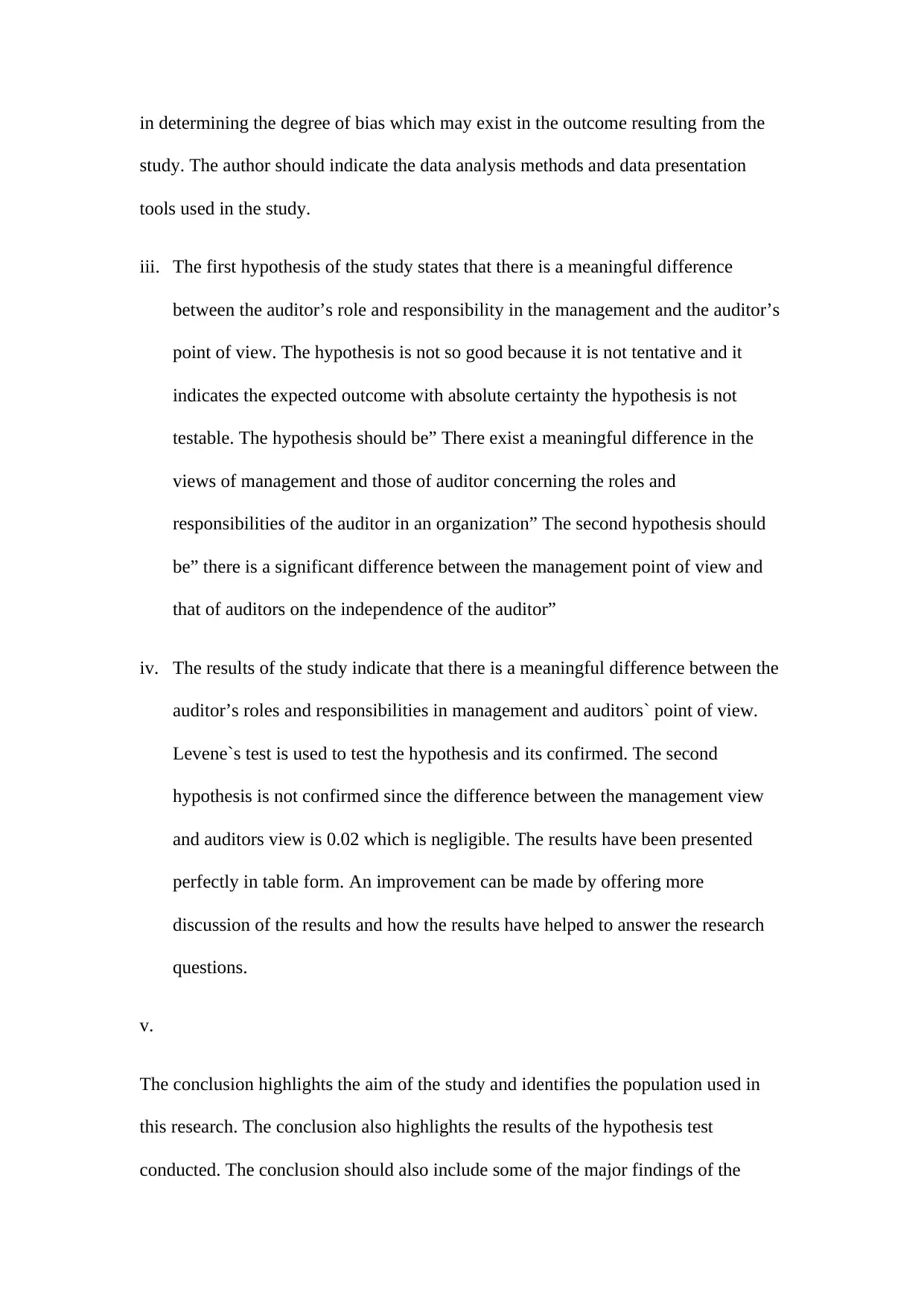
in determining the degree of bias which may exist in the outcome resulting from the
study. The author should indicate the data analysis methods and data presentation
tools used in the study.
iii. The first hypothesis of the study states that there is a meaningful difference
between the auditor’s role and responsibility in the management and the auditor’s
point of view. The hypothesis is not so good because it is not tentative and it
indicates the expected outcome with absolute certainty the hypothesis is not
testable. The hypothesis should be” There exist a meaningful difference in the
views of management and those of auditor concerning the roles and
responsibilities of the auditor in an organization” The second hypothesis should
be” there is a significant difference between the management point of view and
that of auditors on the independence of the auditor”
iv. The results of the study indicate that there is a meaningful difference between the
auditor’s roles and responsibilities in management and auditors` point of view.
Levene`s test is used to test the hypothesis and its confirmed. The second
hypothesis is not confirmed since the difference between the management view
and auditors view is 0.02 which is negligible. The results have been presented
perfectly in table form. An improvement can be made by offering more
discussion of the results and how the results have helped to answer the research
questions.
v.
The conclusion highlights the aim of the study and identifies the population used in
this research. The conclusion also highlights the results of the hypothesis test
conducted. The conclusion should also include some of the major findings of the
study. The author should indicate the data analysis methods and data presentation
tools used in the study.
iii. The first hypothesis of the study states that there is a meaningful difference
between the auditor’s role and responsibility in the management and the auditor’s
point of view. The hypothesis is not so good because it is not tentative and it
indicates the expected outcome with absolute certainty the hypothesis is not
testable. The hypothesis should be” There exist a meaningful difference in the
views of management and those of auditor concerning the roles and
responsibilities of the auditor in an organization” The second hypothesis should
be” there is a significant difference between the management point of view and
that of auditors on the independence of the auditor”
iv. The results of the study indicate that there is a meaningful difference between the
auditor’s roles and responsibilities in management and auditors` point of view.
Levene`s test is used to test the hypothesis and its confirmed. The second
hypothesis is not confirmed since the difference between the management view
and auditors view is 0.02 which is negligible. The results have been presented
perfectly in table form. An improvement can be made by offering more
discussion of the results and how the results have helped to answer the research
questions.
v.
The conclusion highlights the aim of the study and identifies the population used in
this research. The conclusion also highlights the results of the hypothesis test
conducted. The conclusion should also include some of the major findings of the
⊘ This is a preview!⊘
Do you want full access?
Subscribe today to unlock all pages.

Trusted by 1+ million students worldwide
1 out of 17
Related Documents
Your All-in-One AI-Powered Toolkit for Academic Success.
+13062052269
info@desklib.com
Available 24*7 on WhatsApp / Email
![[object Object]](/_next/static/media/star-bottom.7253800d.svg)
Unlock your academic potential
Copyright © 2020–2025 A2Z Services. All Rights Reserved. Developed and managed by ZUCOL.





